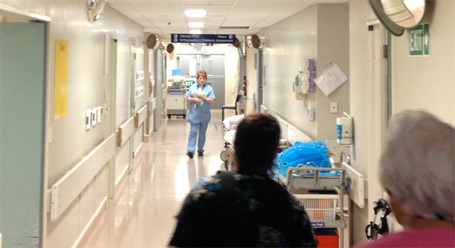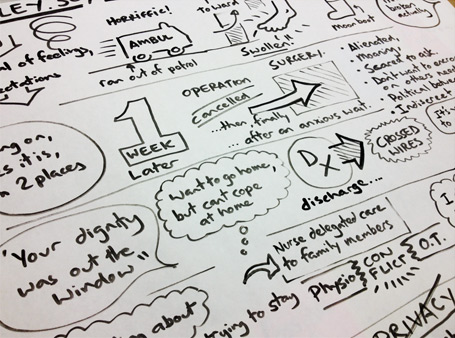How do you share stories collected during dozens of interviews?
What if your ‘Customers’ are actually patients in a hospital?
…Rather than take notes and quotes, why not sketch it ?
Let me explain…
Collecting patient stories
I’ve been part of a team mapping the ‘patient experience’ through a hospital. The foundation for the project is collecting stories from patients in context.
This means interviewing patients at their bedside in Emergency, on wards and later in their homes. The context can be sensitive and the content emotional.

The scale of the work means a raft of interviewers and large number of interviews, each with their own style. The stories have been so rich, diverse and engaging that working to a note-taking template went out the door…
So I began to experiment…
Getting sketchy
At one patient’s house I began sketching her story freestyle, in real time, as she told it.
My partner steered the conversation, while I scribbled furiously with a fat marker and a flipchart on my lap…
Below is a segment of about the first 15 minutes of an interview:

I’m glad I tried it
I’ve spoken before about the power of visualising research findings, and particularly sketched visuals over polished.
A sketch on the project room wall is very accessible, so gets a lot of eyeballs – great for sharing the story. As well as a standalone artefact, It can be a great prompt for discussion – As you talk others through it, somehow the context and tone of the conversation comes flooding back to you. It’s not quite video, but it does bring the story alive.
Try it yourself…
Here’s a ‘Top 10’ …Some starters from my experience:
- This works best if your job is only to listen and capture. Have someone else lead the interview.
- Go BIG – use a large format pad and fat pen. This makes it essay to socialise later, and prevents you from getting too detailed.
- Try to maintain a few seconds ‘buffer’ between what you’re hearing, and what you’re drawing.
- Don’t analyse as you go – just scribble like mad, or your ‘buffer’ will max out and you’ll miss bits.
- Use visual metaphors, e.g. If the subject is looking for something, draw binoculars, magnifying glass, map, compass etc.
- Pepper the notes with verbatim quotes, I use speech or thought bubbles.
- Use a couple of sizes or styles of text to indicate strength of a comment, specific themes etc.
- Talk the subject through the sketch at the end of the interview. They’ll be pleased to see what the hell you’ve been drawing.
- Ask for comment. “What else would you add?” They might correct you in places or add further texture to the story which you can add on the spot.
- If you’re recording with video sit away from the microphone, felt-tip markers make quite a racket when you’re going full-tit.
Give it a try…
This is something I’ll definitely be doing again, trying not to be admitted to hospital myself from marker pen fume inhalation.

Hi Nick,
This post remineded me of this old Core77 post from June 2011. It gives a good summary of how to go about visual note taking.
http://www.core77.com/blog/sketchnotes/sketchnotes_101_the_basics_of_visual_note-taking_19678.asp
I’m a big fan of Sketching to TED talks – I am fascinated with the idea of showing the subject the drawing afterwards – I had tried something similar but it was with a big whiteboard – kind of like a Capgemini graphical scribe would. In my experience it helps to have a tool kit of silhouette/shapes that can be used as story telling devices.
Pingback: Dream design research projects from 2013, Part 1. | User Experience NZ
Pingback: Context is everything, even in a motorcamp | User Experience NZ